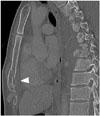This article has been corrected. See "Erratum: Traumatic Sternal Fracture: Incidence, Causes, and CT Features" in Volume 72 on page 439.
Abstract
Purpose
To evaluate the incidence of sternal fracture due to trauma, the CT features of sternal fractures, and the hospitalization period.
Materials and Methods
The medical records and CT images of 755 patients who suffered trauma from January 2012 to August 2013 were analyzed retrospectively. We compared the incidence of sternal fracture due to various traumatic causes. We evaluated the location and shape of the sternal fracture on CT scans and the relationship between a sternal fracture and the hospitalization period.
Results
The incidence of sternal fracture was 9.27% (70/755) in all patients; 11.7% (53/453) due to a traffic accident (TA), and 5.63% (17/302) due to other causes. TA was the most frequent cause (75.71%) of a sternal fracture, fracture incidences after a TA differed by traumatic cause (p < 0.05). Among sternal fractures, the body was the most commonly involved (68.57%), one wall was limited (32.85%), and anteroposterior length increased (7.14%). Body fractures involving two or more segments included 33.33% of the cases. The hospitalization period was not related with sternal fracture (p = 0.30).
Figures and Tables
 | Fig. 1Fracture of sternal body in a 35-year-old man who was struck by heavy object. Sagittal image shows a comminuted fracture involving the mid and lower portion of the sternal body. There is a peristernal hematoma (arrowhead) at the retrosternal area. |
 | Fig. 2Multiple sternal fractures in a 38-year-old woman with driver accident. Sagittal CT scan and curved coronal images show multiple fractures (arrows) in the manubrium and body of the sternum. |
 | Fig. 3Multiple fractures in sternal manubrium and body in a 69-year-old man with driver accident. On sagittal image, the anteroposterior length is increased with fractures (arrowheads) at the upper one-third of the sternal body. There are also focal cortical defects at the lower portion of the manubrium (curved arrow) and at the anterior wall of the lower body (open arrow). Volume rending and curved coronal images show two or more segmental fractures at the upper and lower portion of the sternal body (open arrowheads). Volume rendering and curved coronal images are useful for diagnosing sternal fracture, when a cortical defect of the sternum is only seen without displacement on axial and sagittal images. |
 | Fig. 4Fracture of sternal manubrium in a 43-year-old woman with driver accident.
A. Sagittal CT scan shows a focal defect (arrow) at the anterior cortex of the manubrium and a focal radiolucency in the adjacent medulla. Volume rendering image of the sternum shows one wall-limited fracture (open arrowhead) of the manubrium.
B. Bone scintigraphy obtained 10 days after CT scan shows a hot uptake (open arrowhead) in the inferior portion of the manubrium.
|
Table 1
Sternal Fracture Incidence According to Traumatic Causes

Table 2
CT Findings of 70 Patients with Sternal Fracture

Table 3
Clinical Outcome of Sternal Fracture vs. Non-Fracture Groups

References
1. Goodman LR, Teplick SK, Kay H. Computed tomography of the normal sternum. AJR Am J Roentgenol. 1983; 141:219–223.
2. Stark P, Jaramillo D. CT of the sternum. AJR Am J Roentgenol. 1986; 147:72–77.
3. Restrepo CS, Martinez S, Lemos DF, Washington L, McAdams HP, Vargas D, et al. Imaging appearances of the sternum and sternoclavicular joints. Radiographics. 2009; 29:839–859.
4. Budd JS. Effect of seat belt legislation on the incidence of sternal fractures seen in the accident department. Br Med J (Clin Res Ed). 1985; 291:785.
5. Otremski I, Wilde BR, Marsh JL, McLardy Smith PD, Newman RJ. Fracture of the sternum in motor vehicle accidents and its association with mediastinal injury. Injury. 1990; 21:81–83.
6. Porter RS, Zhao N. Patterns of injury in belted and unbelted individuals presenting to a trauma center after motor vehicle crash: seat belt syndrome revisited. Ann Emerg Med. 1998; 32:418–424.
7. Stark P. Radiology of thoracic trauma. Invest Radiol. 1990; 25:1265–1275.
8. Harley DP, Mena I. Cardiac and vascular sequelae of sternal fractures. J Trauma. 1986; 26:553–555.
9. Aslam M, Rajesh A, Entwisle J, Jeyapalan K. Pictorial review: MRI of the sternum and sternoclavicular joints. Br J Radiol. 2002; 75:627–634.
10. Hills MW, Delprado AM, Deane SA. Sternal fractures: associated injuries and management. J Trauma. 1993; 35:55–60.
11. von Garrel T, Ince A, Junge A, Schnabel M, Bahrs C. The sternal fracture: radiographic analysis of 200 fractures with special reference to concomitant injuries. J Trauma. 2004; 57:837–844.
12. Huggett JM, Roszler MH. CT findings of sternal fracture. Injury. 1998; 29:623–626.
13. Kim EY, Yang HJ, Sung YM, Hwang KH, Kim JH, Kim HS. Sternal fracture in the emergency department: diagnostic value of multidetector CT with sagittal and coronal reconstruction images. Eur J Radiol. 2012; 81:e708–e711.
14. Im DJ, Hahn S, Kim YJ. The usefulness of sagittal reformation for diagnosis of sternal fracture. J Korean Soc Radiol. 2014; 70:25–30.
15. Scaglione M, Pinto A, Pedrosa I, Sparano A, Romano L. Multi-detector row computed tomography and blunt chest trauma. Eur J Radiol. 2008; 65:377–388.
16. Oyetunji TA, Jackson HT, Obirieze AC, Moore D, Branche MJ, Greene WR, et al. Associated injuries in traumatic sternal fractures: a review of the National Trauma Data Bank. Am Surg. 2013; 79:702–705.
17. Helal B. Fracture of the manubrium sterni. J Bone Joint Surg Br. 1964; 46:602–607.
18. Arajärvi E, Santavirta S. Chest injuries sustained in severe traffic accidents by seatbelt wearers. J Trauma. 1989; 29:37–41.
19. Hamilton JR, Dearden C, Rutherford WH. Myocardial contusion associated with fracture of the sternum: important features of the seat belt syndrome. Injury. 1984; 16:155–156.
20. Johnson I, Branfoot T. Sternal fracture--a modern review. Arch Emerg Med. 1993; 10:24–28.
21. Recinos G, Inaba K, Dubose J, Barmparas G, Teixeira PG, Talving P, et al. Epidemiology of sternal fractures. Am Surg. 2009; 75:401–404.




 PDF
PDF ePub
ePub Citation
Citation Print
Print


 XML Download
XML Download